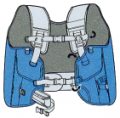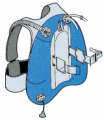Buoyancy control device
A buoyancy control device – also called BDC or jacket – is part of the scuba set and has multiple purposes: It is used to control the buoyancy by adding or releasing compressed air. Furthermore it serves as a carrying device for the diving cylinder, rescue aid and as a swimming aid on the water surface.
Basic knowledge for Open Water Diver* (OWD*)
Components and functionality
A buoyancy control device consists of the following components:
Bladder
The buoyancy body is a flexible bladder that can be filled with air. Adding or releasing air increases or decreases the total volume of the diver and adjusts the buoyancy (see Archimedes' principle). While under water, the goal is to keep a constant volume. This is achieved by adding or releasing air on changes of ambient pressure. The buoyancy of a size M BCD must be at least 15 kg.
Inflator
The bladder can be filled with air from the intermediate pressure outlet of the first stage of the regulator via a corrugated hose with the inflator. The air can also be released via the inflator. You have make the outlet the highest point, as the air in water always rises up.
The inflator must also have a possibility to add air orally to the BCD in an out of air emergency or a malfunction of the regulator or cylinder valve. Never try to breath the air contained in the bladder.
Some manufacturers produce BCDs without the corrugated hose and instead use a mechanical, hydraulic or pneumatic balancing lever. Even there must be a possibility to inflate the BCD orally. This is usually done with a thin tube that is stowed in the side pocket of the BCD. This needs some practice since the little tube is more difficult to find and to operate especially at night, in waves, under stress or with thick gloves compared to a conventional inflator with corrugated hose.
Quick release
A BCD has one or two quick releases. One is usually built in the corrugated hose. There might be another one on the shoulder area and one on the back. Air can usually be released much faster than you are able to add air using the inflator button. In addition, the quick release includes a over pressure valve to protect the bladder from bursting in the event of excessive internal pressure.
When using the quick release, just as when using the inflator, you have to keep in mind that the used release must always be the top point of your BCD. This means that you have elevate your shoulder when you use the quick release on the shoulder or head down for the one on the back.
Straps
Depending on the design, the BCD has different adjustable straps in order to make it easy do get in and out of it and have it sitting firm on your body while diving. The waist belt (cummerbund) and the shoulder straps are usually fitted with quick release buckles.
After putting on the BCD, you must make sure to close all the buckles and tighten the straps so the BCD is sitting firm on the body. This is often easiest leaning forward, letting the scuba gear rest on your back, which takes the weight off of the harness.
Tank strap and tray
There are different systems for attaching the diving cylinder to the BCD. A type of toggle lever is most commonly used. The belt must be threaded through the slots of the buckle in a specific order (see illustration).
The belt gets a little longer when it gets wet. So you should tighten it very good when dry. Good practice is to wet the tank strap before attaching the BCD to the cylinder.
A safety harness, which is attached to the BCD and is placed around the cylinder valve, is mandatory to prevent the cylinder from slipping all the way through just in case the tank strap opens or was not tight enough.
The carrying case is located on the back of the BCD and is used to hold the diving cylinder. It either consists of hard plastic (hard pack) or is completely missing on very light travel BCDs (soft pack). The latter can be folded up smaller. To improve the stability especially on travel BCDs, they are often fitted with two tank straps.
Weight pockets
Modern BCDs are fitted with weight pockets. However, you can still use a weight belt if you feel more comfortable it. Although it is a bit of a hassle to put on the weight belt after the BCD, for safety reasons it is mandatory especially when diving from a boat.
Weight pockets and their locking mechanism must be designed so that they can be inserted as the last piece of equipment. Lock them securely and prevent the pockets from falling out during the dive.
Other
Additional features include lockable pockets for storing diving accessories, e. g. a buoy.
D-rings in the chest and hip area are used to attach lamps, reels, etc. using snap hooks.
A whistle should also be available as an acoustic emergency signal above water. This serves exclusively as an emergency signal and may not be used for any other purpose.
Checks and care
Before each dive you have to carry out the following functional tests on the BCD:
- Function of the inflator (air in and air out).
- Leaks on the quick release and their function.
- Rubber of the corrugated hose and its attachment to the BCD. If the connection leaks, the BCD no longer provides positive buoyancy!
- Tension of the tank strap, as it widens a little when it gets wet.
You should check the BCD for leaks every few weeks by fully inflating the it and letting it stand for a while.
After the dive, you should inflate the BCD, turn it over and drain any water that may have got in through the outlet valve of the inflator or through the quick release valve. Especially after diving in salt water or very dirty water, you should rinse the BCD with clean fresh water.
Knowledge for Experienced Diver** (ED**)
Implementation
BCD's can come as single or double-shell BCD. Double-shell BCDs consist of an airtight inner PVC bladder and the outer a outer body to which the equipment is attached. Such BCDs are flexible and mostly used together with a weight belt. Single-shell BCDs are stiffer because they have to be airtight and robust that the equipment can be attached to them.
There are different types of BCDs:
Buoyancy compensator
The first buoyancy compensators where horse collar type aids which could be inflated orally to adjust for changing ambient pressure. The horse collar was also safe to drowning on the surface. Due to its form it was automatically turning an unconscious diver on his back. Newer jacket type BCDs are just buoyancy aids.
ADV jacket
The air volume in the chest area is lower than with stabilizing jackets. The shoulder straps can be separated in the chest area for easier donning.
Wing jacket
In this type, the air volume on the back is the same on both sides of the tank. This results in a very stable position in the water. However, they can be dangerous for beginners because they can push the diver's head under water when fully inflated on the surface.
Hybrid jacket
Hybrid jackets are a mixture of ADV and wing jackets and try to combine the advantages of both designs.







